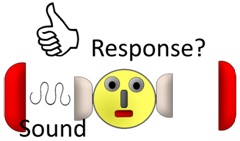Tympanometric screening for Otitis media of paediatric patients with respiratory tract infection in rural setting a prospective observational study
Abstract
Introduction: Early identification of hearing impairment in childhood is imperative, as even a mild hearing loss can have long term consequence on the development of the Central Nervous System. Many children develop transient, fluctuant deafness due to Middle ear effusion, especially during episodes of Common cold. In this research we try to develop a Screening protocol using Impedance Audiometry for early identification of Middle ear effusions.
Materials and Methods: Children between 7 months to 6 years of ages, with no previous history of hearing impairment or ear disease, who were suffering from Upper respiratory tract infection (Common cold) were selected as targets of screening. These children were then subjected to a Screening Tympanometry. A simple, quick and accurate method of screening for Middle ear fluid was “Peak” or “No peak” approach was employed to judge the curves. If a curve was obtained (similar to Jerger's classification-type “A”) child was deemed to have “Pass”. A type “B” curve was deemed highly positive and was labelled “Fail+” and any other trace like type “C” or just reduced type “A” or “As” labelled just “Fail”. Otoscopic and endoscopic examination and diligent search was carried out for signs of Middle ear effusion and confirmation was done. This was cross checked by 2 authors (First and third author) and findings confirmed.
Results: Dervan child screening protocol is 91.67% (92%) sensitive and 94.23 (94%) specific is detection of Middle ear effusions.
Conclusion: Dervan child Middle ear effusion protocol can be used in a cost efficient, scalable and sustainable method of screening children for Middle ear effusion. Tympanometry in selected high risk population is an accurate and reliable test for detection of Middle ear effusion
Downloads
References
2. American Speech-Language-Hearing Association. Guidelines for Audiologic Screening [Guidelines]. Available from www.asha.org/policy. DOI: 10.1044/policy.GL1997-00199 ASHA 34:81–87, 1992.
3. Gelfand SA, Silman S. Future perspectives in hearing and aging: clinical and research needs. Semin Hear 1985; 6:207–219.
4. American Speech-Language-Hearing Association. Guidelines for screening for hearing impairments and middle ear disorders. Asha, April 1990, April 32(Suppl. 2), 17-24.
5. Harford ER, Bess FH, Bluestone CD, Klein JO eds. Impedance Screening for Middle Ear Disease in Children. New York: Grune& Stratton, 1978.
6. Himelfarb MZ, Popelka GR, Shanon E. Tympanometry in normal neonates. J Speech Hear Res. 1979 Mar;22(1):179-91.[pubmed]
7. Paradise JL, Smith CG, Bluestone CD. Tympanometric detection of middle ear effusion in infants and young children. Pediatrics. 1976 Aug;58(2):198-210.[pubmed]
8. Margolis RH, Heller JW. Screening tympanometry: criteria for medical referral. Audiology. 1987;26(4):197-208.[pubmed]
9. Hunter LL, Margolis RH. Multifrequency Tympanometry: Current Clinical Application. Am J Audiol. 1992 Jul 1;1(3):33-43. doi: 10.1044/1059-0889.0103.33.[pubmed]
10. Kasliwal N, Joshi S, Pareek SM. Determinants of sensorineural hearing loss in chronic middle-ear disease. Indian J Otolaryngol Head Neck Surg. 2004 Oct;56(4):269-73. doi: 10.1007/BF02974385.[pubmed]
11. Hammer, Ø., Harper, D.A.T., Ryan, P.D. 2001. PAST: Paleontological statistics software package for education and data analysis. Palaeontologia Electronica 4(1): 9pp. http://palaeo-electronica.org/2001_1/past/issue1_01.htm.
12. Feinstein AR. Clinical epidemiology the architecture of clinical research, Philadelphia, WB Saunders. 1985;10(1):111–45.
13. Roland PS. Chronic suppurative otitis media: a clinical overview. Ear Nose Throat J. 2002 Aug;81(8 Suppl 1):8-10.
14. Briggs RJ, Luxford WM. Chronic ear surgery: a historical review. Am J Otol. 1994 Jul;15(4):558-67.[pubmed]
15. Bluestone CD, Klein JO. Otitis m edia, atelectasis, and Eustachian tube dysfunction. In: Bluestone CD, Stool SE, Kenna MA, eds. Pediatric Otolaryngology, 3rded. Philadelphia: WB Saunders, 1996.
16. Pau HW. [Eustachian tube and middle ear mechanics]. HNO. 2011 Oct;59(10):953-63. doi: 10.1007/s00106-011-2368-y.[pubmed]
17. PROCTOR B. The development of the middle ear spaces and their surgical significance. J Laryngol Otol. 1964 Jul;78:631-48.[pubmed]
18. Jackler RK. The surgical anatomy of cholesteatoma. Otolaryngol Clin North Am. 1989 Oct;22(5):883-96.[pubmed]
19. Shim HJ, Park CH, Kim MG, et al. A pre- and postoperative bacteriological study of chronic suppurative otitis media. Infection. 2010 Dec;38(6):447-52. doi: 10.1007/s15010-010-0048-6. Epub 2010 Aug 11.
20. Yeo SG, Park DC, Hong SM, et al. Bacteriology of chronic suppurative otitis media--a multicenter study. Acta Otolaryngol. 2007 Oct;127(10):1062-7. DOI:10.1080/00016480601126978.[pubmed]
21. Tos M, Poulsen G. Attic retractions following secretory otitis. Acta Otolaryngol. 1980 May-Jun;89(5-6):479-86.[pubmed]
22. Feeney, M. P., & Sanford, C. A. Detection of the acousticstapedius reflex in infants using wideband energy reflectance and admittance. journal of the American Academy of Audiology, 2005;16(5):278-290.
23. De Chicchis, A. R., Todd N. W. &Nozza R. Developmental changes in aural acoustic admittance measurements. journal of the American Academy of Audiology, 2000;11(2), 97-102.
24. Meyer SE, Jardine CA, Deverson W. et al. Developmental changes in tympanometry: a case study. Br J Audiol. 1997 Jun;31(3):189-95.[pubmed]
25. Jerger J. Clinical experience with impedance audiometry. Arch Otolaryngol. 1970 Oct;92(4):311-24.[pubmed]
26. Jerger J, Anthony L, Jerger S, et al. Studies in impedance audiometry. 3. Middle ear disorders. Arch Otolaryngol. 1974 Mar;99(3):165-71.[pubmed]
27. Alaerts J, Luts H, Wouters J. Evaluation of middle ear function in young children: clinical guidelines for the use of 226- and 1,000-Hz tympanometry. OtolNeurotol. 2007 Sep;28(6):727-32.[pubmed]
28. Antonella B, Giovanni D. C. Fundamentals of Clinical Research: Bridging Medicine, Statistics and Operations .75(3):1-3. International Statistical Review. Campbell, M. J.2007.ISSN 0306-7734. 2007. DOI:10.1111/j.1751-5823.2007.00030_3.x

Copyright (c) 2019 Author (s). Published by Siddharth Health Research and Social Welfare Society

This work is licensed under a Creative Commons Attribution 4.0 International License.


 OAI - Open Archives Initiative
OAI - Open Archives Initiative



















 Therapoid
Therapoid

